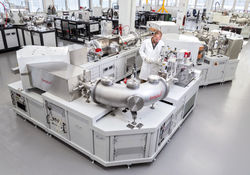
MILEA
Multi-Isotope Low-Energy AMS
In a collaboration, Ionplus and ETH Zurich have developed a next generation multi-isotope AMS system at low energies: MILEA. Covering ¹⁰Be, ¹⁴C, ²⁶Al, ⁴¹Ca, ¹²⁹I, U, Pu and other actinides, the new instrument combines the established accelerator and ion source technology of MICADAS with the well-proven concept of the high-energy spectrometer layout of the ETH “TANDY” instrument.
 |  |  |
|---|---|---|
 |  |  |
 |  |  |
 |  |  |
 |  |  |
 |
With a footprint of just 3.5 m x 7 m, the space requirements of this new AMS instrument are very low. The accelerator is based on the vacuum insulated MICADAS design, which has been upgraded to support up to 300 kV. The low energy spectrometer of the new instrument comprises an achromatic combination of a 90° electrostatic and magnetic defl ector. The layout of the high energy side is inspired by the “TANDY” spectrometer (90° magnetic, 120° electrostatic and 110° magnetic deflector). A quadrupole triplet after the accelerator unit provides similar ion optical conditions for all measured isotopes and facilitates tuning. A new, improved low-noise ΔE-Eres gas ionization chamber at the back end of the new multi-isotope AMS system provides outstanding separation and identification of interfering particles.
The MILEA prototype instrument built and tested in 2017 has shown excellent performance in all tested applications, similar to or exceeding the performance of its higher energy predecessor at ETH. In combination with the new Accelerator Control Software ACS, MILEA is currently not only the most compact but also the most user-friendly multi-isotope AMS system in the world. Contact us to learn more about the exciting possibilities with MILEA.
REFERENCES
-
J. Lachner, M. Christl, A.M. Müller, M. Suter, H.-A. Synal, ¹⁰Be and ²⁶Al low-energy AMS using He-stripping and background suppression via an absorber. NIM B, 331 (2014), p. 209-21
-
C. Vockenhuber, N. Casacuberta, M. Christl, and H.-A. Synal, Accelerator Mass Spectromentry of ¹²⁹I towards its lower limits, NIM B 361 (2015), p. 445-449
-
M. Christl, N. Casacuberta, J. Lachner, S. Maxeiner, C. Vockenhuber, H.-A. Synal, I. Goroncy, J. Herrmann, A. Daraoui, C. Walther, R. Michel, Status of ²³⁶U analyses at ETH Zurich and the distribution of ²³⁶U and ¹²⁹I in the North Sea in 2009, NIM B 361 (2015), p. 510-516





